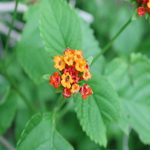| Common Name: |
Yerba Dulce |
| Other Names: |
Aztec Sweet Herb |
| Genus |
Phyla |
| Botanical Name: |
Phyla scaberrima syn Lippia dulcis |
| Native Location: |
Mexico, C America, and the Carribean |
| Cultivation |
Well-drained soil in sun or light shade. |
| Propagation |
By semi-ripe cuttings in spring and summer. |
| Harvest |
Leaves and plants are picked as required and used fresh or dried. |
| Height: |
60cm (24in) |
| Width: |
60cm (24in) |
| Hardiness |
Z10-11 |
| Parts Used: |
Leaves, whole plant |
| Properties |
A very sweet, slightly bitter herb with a camphoraceous aroma. It has expectorant effect and stimulates the uterus. Reputedly abortifacient. |
| Medicinal Uses: |
Internally for coughs and bronchitis, and to induce menstruation. Contraindicated for small children and during pregnancy. |
| Culinary Uses: |
Leaves may be used with discretion for flavoring and sweetening especially herb teas. |
| Bibliography: |
Encyclopedia of Herbs by Deni Bown Copyright © 1995, 2001 Dorling Kindersley Limited. pg 312 |

